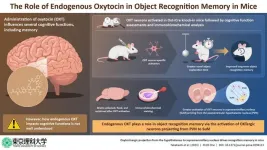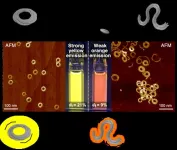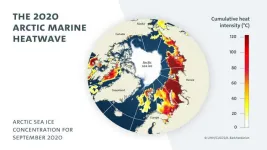(Press-News.org) COLUMBUS, Ohio – A new study examines the circumstances behind who is found at fault when cars hit pedestrians in an urban area.
Results showed that the environment where the crash took place – especially the types of roads and the amount of access to marked crosswalks – played a key role in whether the pedestrian or the driver was blamed for the collision.
In the study, done in Columbus, pedestrians were more likely to be blamed when they were crossing roads with a high volume of cars traveling at faster speeds, and where crosswalks were few and far between.
In areas of the city – such as downtown – where there were more marked intersections with pedestrian crossings, drivers were more likely to be found at fault.
“Our findings suggest that while the tendency is to blame individuals, the built environment where the crash occurs plays an important role,” said Jonathan Stiles, who led the study as a postdoctoral researcher in geography at The Ohio State University.
This was evident in areas of the city where there was an average of a quarter-mile between crosswalks with signals.
“In neighborhoods where there is less pedestrian infrastructure, pedestrians tend to be blamed more for crashes,” said co-author Harvey Miller, professor of geography at Ohio State.
“There needs to be more attention to road design and the built environment that contributes to crashes.”
The study was published recently in the Journal of Transport and Land Use.
Miller and Stiles, who is now a visiting assistant professor at Columbia University, analyzed five years of data on pedestrian crashes in Franklin County, Ohio, the home of Columbus.
There were 2,757 pedestrian crashes in the county between 2015 and 2019. In slightly more than half the crashes (54%), the driver was found at fault, and in 36%, the pedestrian was blamed. No fault was found in the remaining crashes.
As expected, the pedestrian being in the middle of a block or in a travel lane (outside of a crosswalk) increased the likelihood of them being found at fault.
Aspects of the built environment had a strong impact on who was found at fault. Pedestrians were more likely to be found at fault on arterial roads – high-capacity thoroughfares that have heavier traffic and higher speed limits than local roads.
The presence of bus stops in the area also increased the odds of the pedestrian being found at fault – probably because most bus stops are dropping off pedestrians on the busy arterial roads with fewer crosswalks, researchers said, meaning many people may be crossing between blocks.
To get a better handle on how the built environment affected who was found at fault, Miller and Stiles did case studies of various neighborhoods in Columbus.
They found that downtown Columbus – which has pedestrian-friendly street design and infrastructure, with automatic pedestrian traffic controls at most intersections – was the area where drivers were most likely to be found at fault for crashes. Here, drivers were found at fault in 3 out of 4 crashes, and pedestrians were faulted only 17% of the time.
The situation was much different in the Hilltop and South Linden, both of which are lower-income neighborhoods in the city. Unlike in downtown, crosswalks with signals were much less common in these neighborhoods, making it more difficult for pedestrians to cross busy streets safely.
In the Hilltop, pedestrians and drivers were equally likely to be found at fault (46% of the crashes). The researchers described Broad Street, a five-lane arterial road, as “a daunting road to cross with or without a signal in Hilltop, and distances to signalized crossing areas can be several blocks.”
On one part of Sullivant Avenue in the Hilltop, there was an average of 418 meters between signalized intersections – one-fourth of a mile.
The situation for pedestrians was even more difficult in South Linden, a predominantly Black neighborhood to the northwest of downtown, where pedestrians were found at fault in 55% of crashes.
Here, the average distance between pedestrian crossings with signals was 429 meters in some locations.
Some busy areas were well above this average, including one that lacked a crossing for more than 640 meters – about 0.4 miles. That stretch included a mix of residences, retail, day care, religious facilities, a library and bus stops.
“This makes it very difficult for pedestrians who may be carrying bags from a store to find a crosswalk to get across the street,” Stiles said.
“It makes it more understandable why pedestrians may try to cross a street between crosswalks.”
It is also understandable why police officers mark pedestrians at fault on official reports when people get hit while trying to cross in the middle of blocks, said Miller, who is director of the Center for Urban and Regional Analysis at Ohio State.
“Police officers are concerned about the safety of people, so they’re trying to do the right thing when they find pedestrians at fault in these situations,” Miller said.
“But what we’re seeing in this research is that the built environment is a key factor. People make errors in judgment, but no one deserves to die or get injured for such errors. And they would be less likely to make these choices if there were more pedestrian infrastructure,” he said.
One recommendation from the researchers is to redesign the crash forms completed by police to include information on the built environment around the crash site, such as distance to the nearest pedestrian crossing, to give more context on why pedestrians make certain choices.
The built environment for pedestrians isn’t just a problem in Columbus, according to the researchers. Many cities have similar issues. And the situation in Columbus is improving because of Vision Zero Columbus, a government effort focused on reducing crash-related fatalities and injuries in the city.
But this study shows the importance of a Safe System Approach to designing roadways to minimize the effects of human errors and allow pedestrians, as well as cars, to move safely through the city.
“We don’t have to design the streets the way we do. We can make fundamental design choices that could prioritize safety over the speed of traffic,” Miller said.
END
Determining who gets blamed when cars hit pedestrians
Study finds urban environment plays major role in fault-finding
2024-02-13
ELSE PRESS RELEASES FROM THIS DATE:
Oxytocin: the love hormone that holds the key to better memory
2024-02-13
Oxytocin (OXT) is a hormone that is known for its effects on psychological well-being and emotional bonding in animals. Interestingly, research has shown that this natural chemical in the brain plays a crucial role in other cognitive processes as well, including learning and memory. Now, scientists may have discovered exactly how OXT influences memory in animals by studying “OXT neurons” that contain OXT receptors and function differently based on the availability of the chemical in the brain.
In a recent study published on 16 November 2023, in PLOS One, a group ...
Exploring the effect of ring closing on fluorescence of supramolecular polymers
2024-02-13
In supramolecular chemistry, the self-assembly state of molecules plays a significant role in determining their tangible properties. Controlling the self-assembled state has garnered significant attention as it can be exploited to design materials with desired properties like charge transport capability and fluorescence wavelength. For years, scientists have been trying to decipher how molecular organization impacts the properties of supramolecular assemblies that are in the nano (<10 nm) and mesoscopic (10–1000 nm) scales. However, the study of structures with supramolecular polymer assemblies derived from the same monomer is often hindered by dynamic structural ...
Frequent marine heatwaves in the Arctic Ocean will be the norm
2024-02-13
Marine heatwaves will become a regular occurrence in the Arctic in the near future and are a product of higher anthropogenic greenhouse-gas emissions – as shown in a study just released by Dr. Armineh Barkhordarian from Universität Hamburg’s Cluster of Excellence for climate research CLICCS.
Since 2007, conditions in the Arctic have shifted, as confirmed by data recently published in the journal Nature Communications Earth & Environment. Between 2007 and 2021, the marginal zones ...
Greenland’s ice sheet is melting - and being replaced by vegetation
2024-02-13
University of Leeds Press Release
Under embargo until 10:00 GMT on 13 February
There are graphics and photographic images that help explain this story – see under Note to editors
Greenland’s ice sheet is melting - and being replaced by vegetation
An estimated 11,000 sq miles or 28,707 sq kilometres of Greenland’s ice sheet and glaciers have melted over the last three decades, according to a major analysis of historic satellite records.
The total area of ice loss is equivalent to the size of Albania, and represents about 1.6 % of Greenland’s ...
New Durham University research opens avenues for more efficient and stable blue OLED displays
2024-02-13
-With pictures-
A new research from scientists at Durham University reveals an unexpected pathway towards brighter, more efficient, and more stable blue organic light-emitting diodes (OLEDs).
The findings, published in the journal Nature Photonics could help enable the next generation of energy-saving display technologies.
OLED displays, used in most modern smartphones and TVs, rely on light emission from specialised organic molecules.
Obtaining stable, efficient blue emission suitable for displays remains a key challenge.
Now, Durham ...
Study finds childhood bullying linked to distrust and mental health problems in adolescence
2024-02-13
A new study, co-led by UCLA Health and the University of Glasgow, found that young teenagers who develop a strong distrust of other people as a result of childhood bullying are substantially more likely to have significant mental health problems as they enter adulthood compared to those who do not develop interpersonal trust issues.
The study, published in the journal Nature Mental Health on Feb. 13, is believed to be the first to examine the link between peer bullying, interpersonal distrust, and the subsequent development of mental health problems, such as anxiety, depression, hyperactivity and anger.
Researchers ...
Compounds released by bleaching reefs promote bacteria, potentially stressing coral further
2024-02-13
On healthy reefs around the world, corals, algae, fishes and microbes live interconnected and in balance—exchanging nutrients, resources, and chemical signals. New research led by the University of Hawai‘i (UH) at Mānoa and and the Royal Netherlands Institute for Sea Research (NIOZ) revealed that when coral bleaching occurs, corals release unique organic compounds into the surrounding water that not only promote bacterial growth overall, but select for opportunistic bacteria that may further stress reefs.
“Our results demonstrate how the impacts of both short-term thermal ...
Short corrective comments can help social media user to spot false information, study shows
2024-02-13
Short and simple comments from ordinary social media users can help others online to spot fake news, a new study shows.
Research shows reading corrections from others online can reduce the perceived accuracy of and engagement with incorrect content.
Experts found the format and strength of corrective comments do not matter much. Social media users do not need to write long and detailed comments to flag false content.
While the study shows the general effectiveness of social correction, it also finds ...
Biomarker-directed combination effective in immunotherapy-resistant lung cancer
2024-02-13
HOUSTON ― A specific combination of targeted therapy and immunotherapy may better help patients with non-small cell lung cancer (NSCLC) overcome inherent immune resistance and reinvigorate anti-tumor activity, according to a new study led by a researcher from The University of Texas MD Anderson Cancer Center.
Results from the Phase II umbrella HUDSON study, published today in Nature Medicine, demonstrated that the anti PD-L1 antibody, durvalumab, coupled with the ATR inhibitor, ceralasertib, provided the greatest clinical benefit of four combinations evaluated.
This pair had an objective response ...
Plant-based diet tied to improved sexual health in men treated for prostate cancer
2024-02-13
A diet that limits meat and dairy but is rich in fruits, vegetables, grains, and nuts is linked to less erectile dysfunction, urinary incontinence, and other common side effects seen in prostate cancer patients, a new study shows.
Led by researchers at NYU Grossman School of Medicine and Harvard T.H. Chan School of Public Health, the analysis of more than 3,500 men with prostate cancer explored whether eating a more plant-based diet was associated with quality-of-life issues that often arise after treatment. Sorting patients into five groups (quintiles) based on the proportion of plant versus animal foods the men said they eat, the authors found ...
LAST 30 PRESS RELEASES:
Numbers in our sights affect how we perceive space
SIMJ announces global collaborative book project in commemoration of its 75th anniversary
Air pollution exposure and birth weight
Obstructive sleep apnea risk and mental health conditions among older adults
How talking slows eye movements behind the wheel
The Ceramic Society of Japan’s Oxoate Ceramics Research Association launches new international book project
Heart-brain connection: international study reveals the role of the vagus nerve in keeping the heart young
Researchers identify Rb1 as a predictive biomarker for a new therapeutic strategy in some breast cancers
Survey reveals ethical gaps slowing AI adoption in pediatric surgery
Stimulant ADHD medications work differently than thought
AI overestimates how smart people are, according to HSE economists
HSE researchers create genome-wide map of quadruplexes
Scientists boost cell "powerhouses" to burn more calories
Automatic label checking: The missing step in making reliable medical AI
Low daily alcohol intake linked to 50% heightened mouth cancer risk in India
American Meteorological Society announces Rick Spinrad as 2026 President-Elect
Biomass-based carbon capture spotlighted in newly released global climate webinar recording
Illuminating invisible nano pollutants: advanced bioimaging tracks the full journey of emerging nanoscale contaminants in living systems
How does age affect recovery from spinal cord injury?
Novel AI tool offers prognosis for patients with head and neck cancer
Fathers’ microplastic exposure tied to their children’s metabolic problems
Research validates laboratory model for studying high-grade serous ovarian cancer
SIR 2026 delivers transformative breakthroughs in minimally invasive medicine to improve patient care
Stem Cell Reports most downloaded papers of 2025 highlight the breadth and impact of stem cell research
Oxford-led study estimates NHS spends around 3% of its primary and secondary care budget on the health impacts of heat and cold in England
A researcher’s long quest leads to a smart composite breakthrough
Urban wild bees act as “microbial sensors” of city health.
New study finds where you live affects recovery after a hip fracture
Forecasting the impact of fully automated vehicle adoption on US road traffic injuries
Alcohol-related hospitalizations from 2016 to 2022
[Press-News.org] Determining who gets blamed when cars hit pedestriansStudy finds urban environment plays major role in fault-finding




